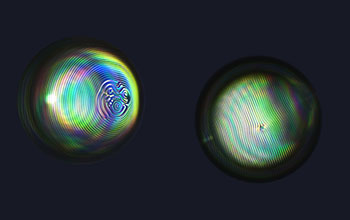Multimedia Gallery
Liquid crystals within droplets
Researchers at the University of Pennsylvania confined liquid crystals within droplets, creating shells floating in water. To create patterns, they added surfactants to the water, which were attracted to the liquid crystal shells, causing the molecules to order in different ways and create striking patterns.
More about this image
While investigating patterns in liquid crystals, Lisa Tran, a graduate student in the Department of Physics and Astronomy at the University of Pennsylvania’s School of Arts and Sciences, discovered dancing iridescent spheres with fingerprint-like patterns etched into them that spiraled and flattened as the solution they were floated in changed.
Liquid crystals -- fluids with aligned phases of constituent molecules -- are used in everything from computer and television displays to mood rings. Since liquid crystals are made of rod-like molecules, they have special optical properties, such as changing color as they interact with electrical signals or light.
For her research, Tran confined the liquid crystals within droplets, creating shells floating in water. To create patterns, she then added surfactants, or soapy molecules, to the water.
"The way that soap usually works," says Tran, "is that you mix it with water and it forms small droplets with the oil to remove it from your hands or your plate."
Because liquid crystals are similar to oil, the surfactants were attracted to the liquid crystal shells, causing the molecules to order in different ways and create striking patterns. The more soap she added to the solution, the more the patterns changed. Adding water caused the patterns to reverse. Being able to control the patterns that form on the liquid crystals could be useful in creating patchy colloids, microscopic particles suspended in water that are functionalized, meaning one can attach molecules to specific spots on the particle.
The research, supported by a grant from the U.S. National Science Foundation, is a key component in one of the interdisciplinary research groups of Penn’s recent NSF Materials Research Science and Engineering Center grant (grant DMR 1120901). The group is working to make assemblies of nanocrystals on hard templates and within soft materials that hold promise for applications in sensing, energy conversion and optical-signal processing.
To learn more about this research, see the NSF News From the Field story Penn researchers demonstrate how to control liquid crystal patterns. (Date image taken: 2017; date originally posted to NSF Multimedia Gallery: March 14, 2018)
Credit: Lisa Tran
Images and other media in the National Science Foundation Multimedia Gallery are available for use in print and electronic material by NSF employees, members of the media, university staff, teachers and the general public. All media in the gallery are intended for personal, educational and nonprofit/non-commercial use only.
Images credited to the National Science Foundation, a federal agency, are in the public domain. The images were created by employees of the United States Government as part of their official duties or prepared by contractors as "works for hire" for NSF. You may freely use NSF-credited images and, at your discretion, credit NSF with a "Courtesy: National Science Foundation" notation.
Additional information about general usage can be found in Conditions.
Also Available:
Download the high-resolution JPG version of the image. (255.2 KB)
Use your mouse to right-click (Mac users may need to Ctrl-click) the link above and choose the option that will save the file or target to your computer.



